Your winter camping site and shelter will be a major determinate to your comfort during the evening hours. On winter’s long nights, the campsite is where you will spend considerable time cooking and eating meals, relaxing with companions and sleeping overnight. Your will want to consider site selection factors as well as choose an appropriate type of winter shelter.
8.1 Site Selection and preparation
Selecting a comfortable camp site is a useful skill for all campers, regardless of the season. Here are factors to evaluate when assessing different camping locations:
- Does the site conform to camping regulations?
- Is there available water or suitable snow to melt?
- Is your campsite at least 150 feet away from a water source?
- Is your campsite safe from hazards such as hung or dead tree branches, rock falls, snow slides or avalanches?
- Is the campsite fairly level?
- Is the campsite set off from hiking trails and game trails? Is the campsite private and quiet?
- How exposed is the site to wind? You will want to avoid the lowest ground in the area as the coldest air will settle overnight. Atop a slight knoll protected by trees is best.
- Evaluate the site in context of a storm. Will the site remain safe? Will you be able to easily evacuate?
- If you plan on having a fire is there a pre-existing fire ring or suitable site for a fire pit. Is there suitable and available wood?
- Is there a useful (e.g. protected, comfortable) site to cook and eat your meals?
Select a protected campsite out of the wind and off the valley floor and other low areas where cold air settles. Look for natural wind blocks like large boulders, rock outcroppings, or dense stands of trees protect against wind. Breezes blow up canyons or mountains during the day, and down at night. If you camp near a steam, cold air travels down water corridors. Don’t set your tent or build a fire under trees that have snow on their branches.
Consider orienting your site toward the east to catch the sun’s early morning rays. If you want to get an early start or capture early warmth this tactic may help in the morning.
If you are sleeping in a lean-to you should consider hanging a tarp across the opening to help eliminate breezes. Similarly, if you are sleeping in the open, a snow wall or tarp can serve as a wind block.
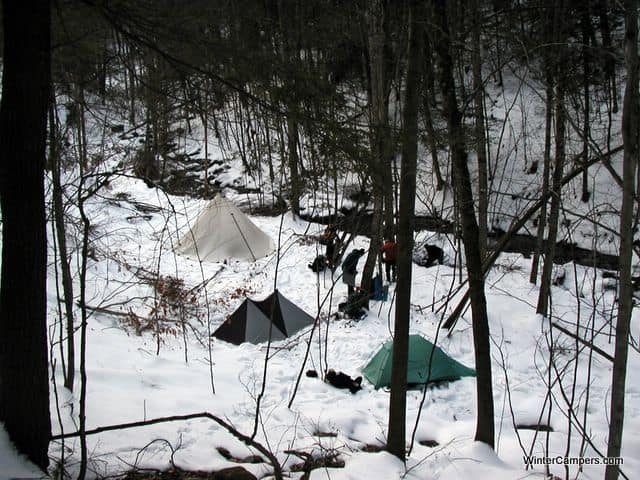
A tipi, tarp tent and three season tent display a range of winter camping shelters.
8.2 Winter Camping Shelter Alternatives
Winter camping shelter options are numerous to include:
- snow shelters such as quinzees, snow caves and igloos,
- pre-existing structures such as lean-tos,
- tents such as hot/cold tents, hammocks, four season tents, tipis, tarps and bivy sacks.
There are many alternatives for winter camping shelters each with their own tradeoffs.
|
Shelter |
Description |
Advantages |
Disadvantages |
| Lean-To | Three sided roofed enclosure with a plank floor usually made of logs | It’s already there! Spacious: room to change clothes, room for cooking, can sleep 6+. Up off the ground | Limited to specific areas, expensive to build, large open face makes it susceptible to wind. Not particularly warm. Usually situated in high-use areas. May have to share |
| Tent | Solo or multi-person tent | Readily available, wide variety | Must be carried and set up. |
| Hammock | A fabric sling suspended between two points, used for sleeping | Light weight, easy to pitch in wooded areas, no level ground necessary | Accessories needed to “winterize” otherwise a hammock can be cold, no space for sitting |
| Hot Tenting | The main features of this approach are a canvas tent with a woodstove, breathable cotton outerwear, wool clothing insulating layers, traditional snowshoes and mukluks, and sleds (usually toboggans) to haul the extra gear. | Warm. Stove provides cooking and enables drying of clothing. | Heavy. Stove & stove pipes are an additional item (and weight) to transport. Most fireboxes are limited and require constant attention |
| Bivy | A waterproof shell over a sleeping bag providing insulation and a wind and moisture barrier | Light weight, camp anywhere, easy to set up | Can be constricting, no shelter for gear, not easy to enter/exit |
| Tarp | a sheet of flexible, water-resistant material with attachment points allowing it to be tied down or suspended | Light weight, easy to set up. Multiple configurations possible | Not wind proof or particularly warm, no ground protection |
| Snow Cave | A shelter dug into the snow to protection from wind as well as low temperatures. | Relatively warm | Construction takes time, you can get wet in the construction, requires deep snow drifts |
| Quinzee | A shelter made by hollowing out a pile of settled snow. | Easily constructed in less than ideal snow conditions | Construction takes time, you can get wet in the construction. Less sturdy than an igloo. |
| Igloo | A shelter constructed from blocks of compacted snow in the form of a dome. | Relatively warm, long lasting and durable | Construction takes time, skill or experience is needed. You can get wet in the construction. |
8.3 Lean tos
The Lean-to is an open faced camping shelter found throughout the Adirondack Park back-country areas and along the Appalachian Trail. They are also found in the Nordic European nation of Finland, although in Finland they are called “laavus” instead. These Finnish lean-tos serve as temporary housing for people on hiking, camping or fishing expeditions out in the wilderness. They are especially common in the Pukala national forest of Finland.
Lean-tos are built mostly by hand with chainsaws and chisels and the logs are assembled using a scribe notching technique that results in a very tight fit of joints and allows the use of the entire length of logs. The floor space usually measures 12′ x 8′ in size.
The original plans for building a lean-to were published by the New York Conservation Department – Bureau of Camps and Trails in March 1957 entitled as Plan # 184.
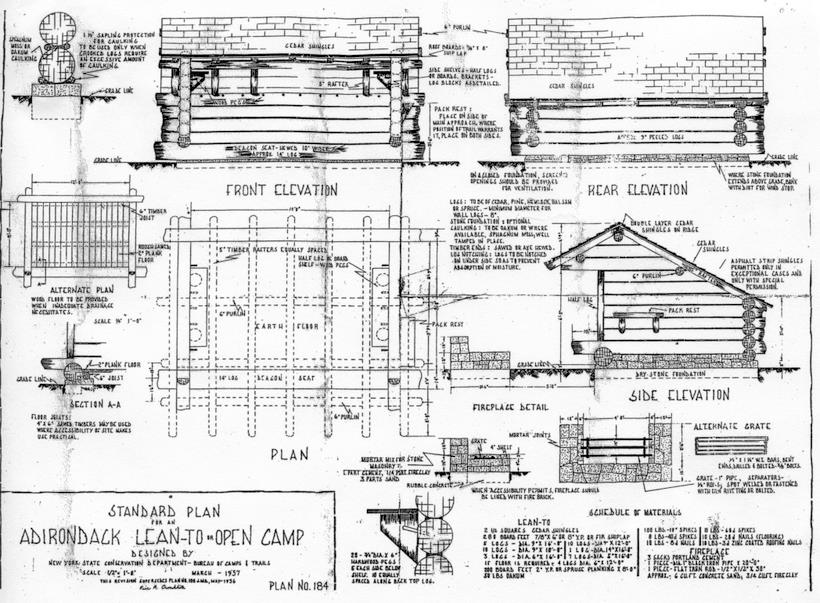
Original NYS Plans for building a lean-to
New York State maintained lean-tos are open to any and all comers up to the marked capacity of the shelter. As is the case at other campsites, you may not stay at a lean-to for more than three consecutive nights without a free DEC permit. When using a lean-to, don’t hammer nails into the logs or make other “improvements.” It’s even illegal to set up a tent inside a lean-to!
There are benefits to winter camping in an lean-to. Foremost, is that you don’t have to carry your shelter with you. They are spacious; although each lean-to can be different typically there is adequate room for 5. The lean-to provides a level, dry platform for changing clothes, setting up a stove, mixing food, or just plain sitting.
On the other hand, lean-to’s aren’t particularly warm – even if you close off the open side with a tarp. They are usually situated in high-use areas. And the sleeping arrangements can leave you lying wide awake between two prodigious snorers.
In the past 12 years of winter camping only once have I encountered a lean-to in use by other winter campers. On Martin Luther King weekend at the popular John Pond lean-to in the Siamese Ponds Wilderness Area a boy scout troop had hiked in before us and were staying at the lean-to, so we tented.
8.3.1 Appalachian Trail Lean-tos
WhiteBlaze, a forum dedicated to the Appalachian Trail, has a forum devote to shelters and lean-tos along the Appalachian trail[1] where users share their shelter experiences and discuss issues related to shelters of lean-tos from Georgia to Maine.
8.3.2 NYS Lean-tos
DSettahr over at Adirondack Forums[2] posted a spreadsheet of all the lean-tos in the Adirondack and Catskill Mountains. He stated it was his “(long term) hiking goal… to spend a night in every single lean-to in the Adirondacks and the Catskills.”

The spreadsheet has two pages: one that has all the lean-tos listed in alphabetical order and one that lists them by the management unit in which they reside. Currently, there are 295 lean-tos on the list. Subsequent posters noted corrections where lean-tos no longer existed..
8.3.3 Sharing Lean-tos
The guidelines for sharing lean-tos state that while it is nice to share lean-tos there are no regulations requiring they be shared.
User ‘WildRiver’ stated “There is no regulation compelling lean-to users to share the shelters with latecomers. Latecomers have no regulatory right to move into lean-tos that are currently being occupied, even if there is room. On the other hand: No one can claim exclusive occupancy of any portion of state land, whether it is a lean-to or an off-trail campsite in the middle of nowhere. Basically, the state’s land use regulations are completely mum on the topic of sharing campsites. No matter where you go in the Forest Preserve, you have no guaranteed “right” to solitude, nor do you have the “right” to intrude on someone else’s.
However, there is by all means a valid expectation for solitude. The word is an integral part of the legal definition of “Wilderness Area,” meaning that solitude is a feature the state is officially trying to promote and perpetuate. In fact, the Five Ponds Wilderness UMP specifically addresses people “who go into the wilderness primarily as a social excursion seeking the company of others and facilities where they might congregate” by stating: “Users” in [this] category are not really seeking a wilderness or the experience of it. Therefore, the accommodation of user group 5 is not a goal in the management of this unit.
So there is an official obligation to provide “outstanding opportunities for solitude,” and in fact this is a key part of the wilderness experience. Most people that you meet in the back country are in search of privacy to one degree or another, and it is to everyone’s mutual benefit to give each other space when choosing a campsite.”
The formal New York State DEC regulations on use of state land addresses lean-tos stating:
a) Open camps (lean-tos) may not be occupied by the same person or persons for more than three successive nights or for more than 10 nights in any one calendar year, provided others wish to use such camps.
b) The enclosure of the fronts of open camps is prohibited, except by tying canvas or nylon tarpaulins in place or erecting snow walls. The use of wood, nails, screws or other fasteners is prohibited.
c) The erection of tents in open camps is prohibited.
8.3.4 Lean-to Registers
“Decided to sleep in lean-to, floor like C-ment. To those who come behind us, bring a mattress. – Griffin Rapids.”
Finally, there is always the added benefit of reading the lean-to register for entertainment as captured in No Place I’d Rather Be: Wit and Wisdom from Adirondack Lean-tos by Stuart Mesinger. Stuart took several years and read hundreds of registers to compile his book. He received permission (and sponsorship) from the ADK to go through the register archives. Stuart flagged the interesting entries, had a High School student type them up and then organized the book into themes: love stories, tall tales, partying, complainers, weather, critters, bugs, food, the privy, the campfire, the long walk, adventures, culture clashes, hunting and fishing, companions, religion and solitude.
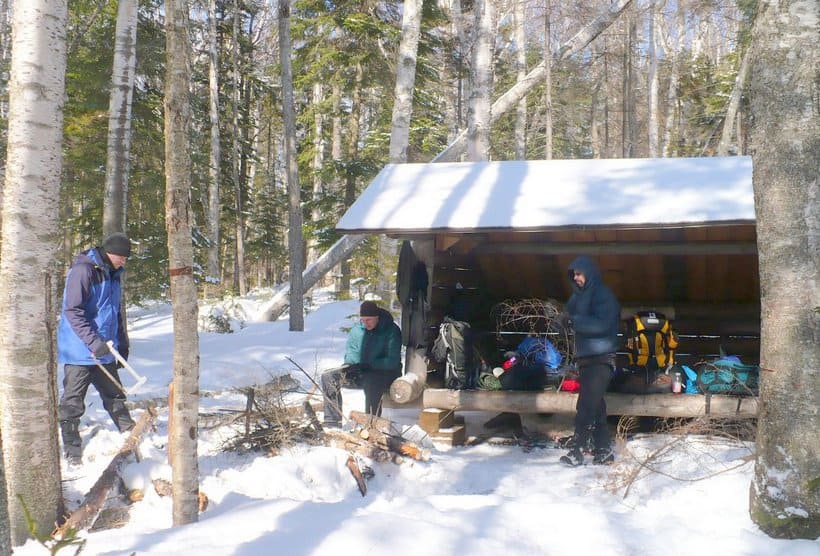
Camping in a lean-to offers copious space and a site off the snow covered ground.
8.4 Tents, tarps Bivys & Tipis
Hot or cold tenting? Each style of winter camping has its proponents.
Hot tenting is a blend of Native American and 19th century European techniques and equipment. It usually involves packing a wood stove along with a more substantial, usually canvas, tent, since one is spending time in the heated tent and it is not just a sleeping berth. Hot tenting may entail bringing your gear on a sled, toboggan or pulk. Advantages include lounging in comfort, the ability to dry out clothes and cook in the shelter. Disadvantages include an increased weight, set up time and the need to cut fuel. Hot tenters often establish multi-day base camps.
Cold tenting usually involves a lighter load that can be easily backpacked, permitting more mobility. Cold tenters rarely stay in the same place more than one night. The disadvantage of moving your tent is that it gets tough to dry out gear on trips of long duration.
Tim Jones has a nice article[3] entitled “Cold Can Be Warm: Two Ways to Winter Camp” comparing cold and warm camping, otherwise known as hot tenting. From Tim’s article:
“Cold camping means camping without a heat source, relying on a tent or tarp to shelter you from wind and falling or drifting snow, and warm clothes and a good sleeping bag to keep you comfortable. Though “cold camping” doesn’t sound all that appealing, you can be surprisingly comfortable in a “cold” camp.
The big advantage of cold camping is that your pack is lighter and you are more mobile. Almost any trail you’d backpack on in the summer is fair game for a winter cold camping trek. With a free-standing tent, it’s easy to travel on snowshoes or skis, reach your destination and, an hour later, be well fed and snug in your sleeping bag for the night. The only moment of potential discomfort unique to cold camping is hauling yourself out of that cozy sleeping bag in the morning. But, if you planned it right, you’ve already had something warm and comforting to eat and drink before you have to get up and get dressed for the day.
Warm winter camping is something of a misnomer, since it isn’t warm all the time. You spend your days and nights in the same cold as cold campers. Typically, the only “warm” in warm winter camping is in the evenings and perhaps again in the morning when you are awake and in camp to tend to some sort of heat source. That heat source might be a campfire in front of a tarp shelter, a woodstove inside a tent or even a candle lantern inside a snow cave or snow shelter – which can be surprisingly cozy. It would seem that gas-fueled catalytic heaters would be ideal inside a tent, but I’ve never found a stove/fuel combo that’s light and efficient enough to carry backpacking.
The advantage of warm camping is obvious – you aren’t confined to your sleeping bag when you aren’t moving. You get to dress and undress, eat and relax in a warmed space.
Warm camping also has its disadvantages. Warm setups are usually – but not always – heavier than cold camping. And it usually takes a lot more time to set up a tarp-and-campfire site or a woodstove-heated tent or to build a snow shelter than it does to pop up a free-standing tent. Then there’s the time and effort it takes to find wood for a campfire or stove – not always easy when the snow is deep.
Warm camping works better when you spend more than one night at a campsite rather than moving camp every day. A warm camp is perfect for a long weekend. Pack in and set up camp your first day, leaving plenty of time to find wood if needed. The following days you can explore out from there, knowing you can return to a snug haven.
8.4.1 Four Season Tents
Despite what the name implies, four-season tents are actually one-season tents: winter. Both the canopy and body feature stronger materials than three-season tents, and the body shape maximizes resistance to high winds and heavy snow loading. There is a corresponding increase in both durability and weight over summer or three season tents.
Defining features of a four season tent designed for mountaineering and winter camping are:
- All vents can be closed during storms.
- Tougher materials than three-season tents.
- Multiple guy-out points for anchoring.
Four season tent considerations include:
Size. When weight is an issue get a tent for the exact number of anticipated users. If you’re planning for a base camp then consider a larger tent; every extra inch counts when you’re sitting through winter’s long nights.
Single or Double-Wall Tent. Get a single-wall tent for long backcountry tours. Get a double-wall tent for trips where you will be in the same camp for several nights. Single wall tents are usually lighter and if vented properly, moisture usually isn’t much an issue in the winter.
1 Door vs. 2 Doors. For winter tents the door question usually gets answered when you think about how much time you’ll be on the move. In base camp, a second door can be key; some find the convenience of a second door to be well worth the extra few ounces, especially for tents that hold three or more people. A second door may eliminate uncomfortable situations and climbing over others during exits.
Vestibule. Vestibules provide a place to store gear and put on your boots without exposing the inside of your tent to a snowstorm. When camping on deep snow, you can dig out below the vestibule to create a plush porch and storage area. Four-season single-wall tents often do not have an integrated vestibule because the people using these tents tend to focus on saving weight.
Venting. The trade-off is to include just enough venting to reduce condensation while maintaining warmth, but be able to seal up the tent to keep out blowing snow during a storm.
Footprint: While footprints add extra water resistance and durability for long stays they are unnecessary when camping on snow.
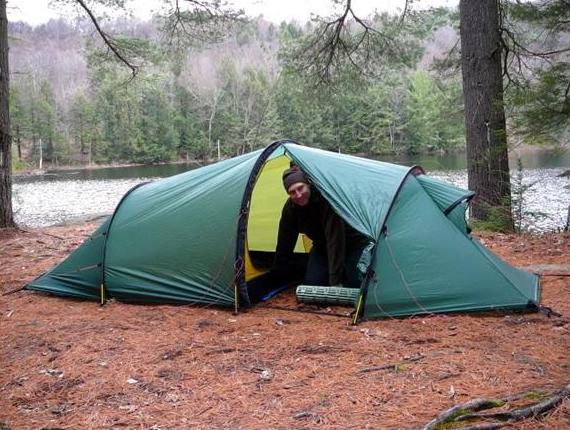
A winter camping tent offers vestibule space for gear and cooking.
8.5 Tarps & Bivy sacks
Tarps are lighter to carry than winter tents and can fulfill a variety of functions: wind break, snow moving, dining fly, ground cloth, or a roof on a partial snow shelter.
While not as warm as a tent, using a tarp as your primary shelter can be rewarding. You are offered a variety of pitching options, a tarp ventilates well, and you can position yourself to be able to see the night sky if desired.
A bivy bag is intended for a bivouac, an emergency camp, and is designed for a very short stop. It is something you use when you are caught out without full camping gear, either by choice or in an emergency. A bivy is not intended to be a comfortable rest and is often used in a location where you normally would not stop. Your gear stays outside in the weather as there is no room in the bivy sack. Getting in and out of bivy sack during the winter can be problematic. Exiting a bivy sack in the middle of a winter night to heed nature’s call can be doubly so. They are not designed to accommodate easy access.
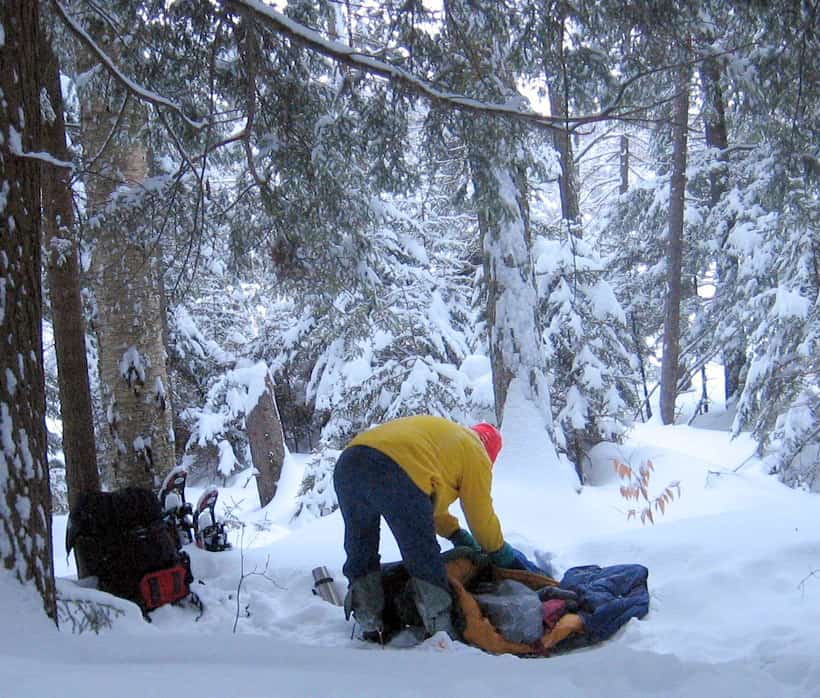
A bivy bag doesn’t require a large camp site.
There are many single wall tents available in the 3 lb range, which can offer more convenience than a bivy sack. Having said that, many people use a bivy bag for protection when sleeping in a snow shelter or directly on the snow or to add comfort range to their sleeping system since a bivy sack adds 5-10 degrees.
8.5.1 Tipis
I bought a Black Diamond Megamid Tipi Tent with thoughts that it could be used for emergency shelter when canoe camping, but especially for winter camping. The tipi sets up easily on snow and over uneven ground.
The four person Megamid is supposed to sleep 4 persons, but I am sure they never made those calculations with 6’4″ campers in mind. However, it was palatial with 2 and adequately fits 3 sleeping forms quite well.
The Megamid provides 51 square feet of floor space, one door and measures nearly 5′ (57″) tall. Total weight of the tent, pole, stakes and stuff sack is less than 4lbs.
On our maiden winter camping with the Megamid – having little experience with tipis at this point we didn’t stamp out a large enough footprint. However, the tipi worked fine. The tipi form sheds snowfall easily with a soothing swooshing sound through the night as accumulated snow slides down the side.
Since the Megamid doesn’t have a floor we packed a space blanket to provide coverage below the sleeping pad, so I am not too sure about overall weight savings.
It is nice to be able to enter the tipi with boots on and not worry about tracking snow in. Cooking inside is an option, however, like any single wall tent condensation can be an issue if there isn’t adequate ventilation.

A small tipi provides adequate space for winter camping.
8.5.1.1 Hot Tenting with a Tipi
A nice compromise between the comfort of hot tenting and the lightness and mobility of cold camping is the lightweight Kirafu Tent. It is light and easy to set up. It accommodates 4-5 campers with a wood stove and wood. If you want to be warm – it can get very warm.
The Kifaru 8 Man Ultralight Tipi weighs 12 lbs for an 8 man tent including a large packable wood stove. The tipi is made of an ultralight fabric which resembles parachute material. The tipi material itself is very light and easily stuffs into a small sack. It has one aluminum center pole and several stakes.
Set up is easy. If there is a lot of snow it is beneficial to dig or stamp out the area first for easier set up, especially if you don’t have the longer tent stakes. Taking the time to clear out the snow saves a lot of time and trouble in the end.
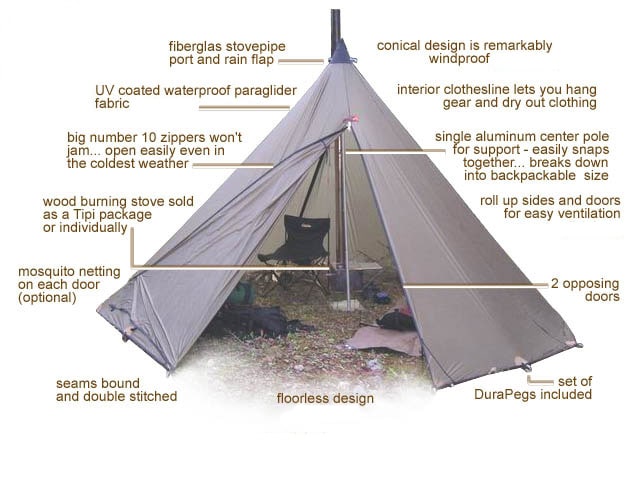 Parts of a Kirafu Tipi
Parts of a Kirafu Tipi
What is touted as an eight person tent will comfortably fit five tall campers with the wood stove and a supply of wood. Without the stove the tent will fit six persons.
The wood stove is stainless steel and weighs in at just over 4lbs. When folded up it is roughly the size of a laptop and comes in its own carrying case. With 20/20 hindsight it is recommended that you roll the stove pipe a few times at home first in order to loosen it up a bit and to get the hang of it. Once set up it is time to build your fire.
The firebox is 8×9×20”. You will have to keep the wood small since the door only allows wood of approximately 3.5 inches in diameter. Burn time is about an hour; however, you can easily warm the inside of the tipi up into the 70s. The sides of the stove and stovepipe do become red hot so you will want to make sure that the sleeping bags, packs, bare skin, etc. stay well away. If you wish to have a fire going all night it is important to position a light sleeper near the stove. Unless you just plan on re-lighting it in the morning you need someone to who sleeps lightly to keep waking up and throwing a few pieces of wood on every hour or so. We have found the stove to be an adequate cooking stove. The stove is sturdy enough to hold pots of boiling water, frying pans etc.
A platform is necessary under the stove to prevent it from melting down into the snowpack below as it heats through the night.
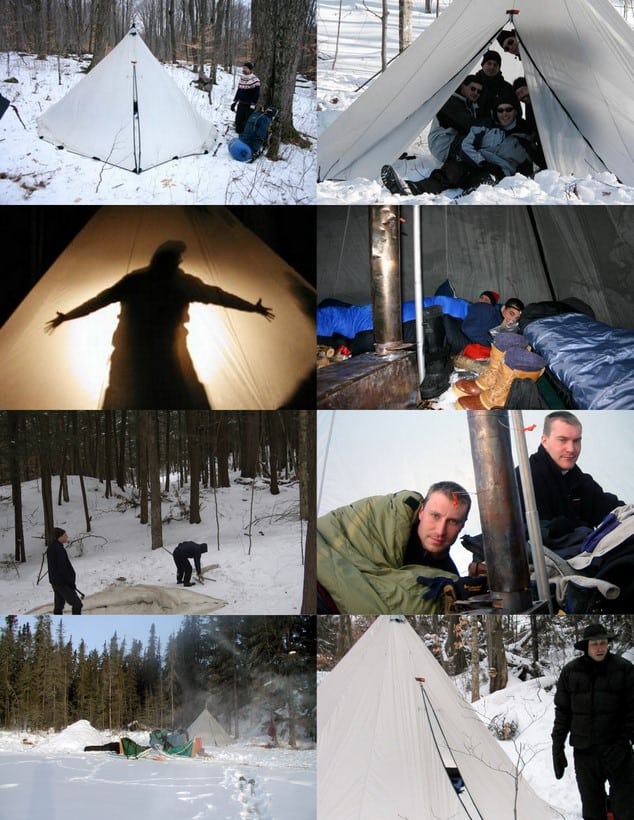
A variety of views of winter camping in a tipi
8.5.2 Tent Color Considerations
I have never given tent color much thought when purchasing a new tent. Unlike buying a pair of pants, there aren’t always color options when selecting a particular tent model. However, there is a lot of thought that goes into the selection of a tent color by the manufacturer. One thing to consider if you do snow camping and spend time inside during the day is that yellow lets in a lot of light which might lead to snow blindness on a sunny day. Years ago REI did tests of colors and decided a dark orange was best for mountaineering tents- they were cheery and easy to find, but cut down on light more to help stave off snow blindness. Most people prefer:
- bright colors if they snow camp,
- navy, black, green or gray if they trail hike and like to hide from the crowds,
- black or navy for desert conditions as they provide better shade with a ventilated pitch,
- orange or yellow for emergency shelters and search and rescue,
- yellow for river trips for mood enhancement on rainy days,
- blaze orange, green or gray for hunters (depending on the type of hunting military tactical) gray or green for those in bear country ( to avoid visually attracting them)
- photographers like a bit of color in their photos.
|
Color |
Advantages |
Disadvantages |
| Navy | The NOLS color choice for blending in as it blends in well at dusk and semi-darkness, doesn’t attract attention from people or animals. It dries quickly in sunlight. It makes the best shade if an ample insulating air distance (3 ft) is kept between you and the tarp. Best projection from snow blindness. | It lets less light through, dreary in dreary weather, can be hot in hot weather if fabric is close to the body. |
| Purple, Brown, Royal | It blends in well at dusk and dark, doesn’t attract attention from people or animals. It dries quickly in sunlight. It makes the best shade if an ample insulating air distance (3 ft) is kept between you and the tarp. Best projection from snow blindness. | It lets less light through, dreary in dreary weather, can be hot in hot weather if fabric is close to the body. |
| Grey | Popular with many backpackers. It blends in well in many settings. It doesn’t attract attention from people or animals. It lets lots of light through. | Dreary in dreary weather, lets radiant heat through in hot weather (doesn’t provide dark shade), little protection from snow blindness. |
| Bright Orange or Chartreuse | A favorite of Search and Rescue and survival kits. It is cheery in dreary weather, easily spotted in emergencies or when returning to camp in stormy weather. It lets lot of light through. It provides hunting safety. | It shows dirt, may attract attention from people or animals, gives little shade, and gives little protection from snow blindness. |
| Leaf Green | The stealth camper’s choice. It blends in well in many settings. It lets some light through, good compromise for all around use. | Difficult to locate in twilight conditions |
| Gold | It is cheery in dreary weather, easily spotted in emergencies or when returning to camp in stormy weather. It lets lot of light through. |
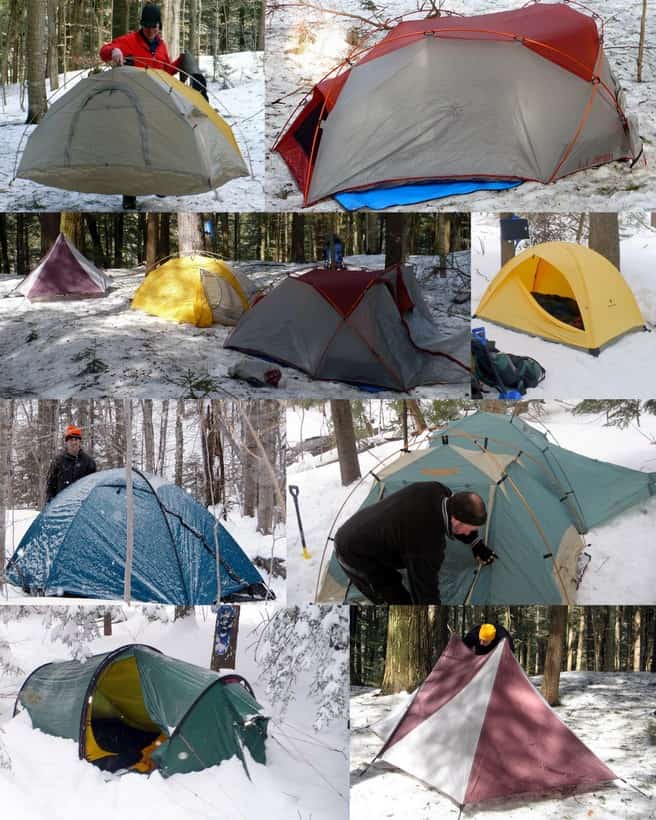
A variety of tent color options for winter camping.
8.5.3 Staking Out
Regular tent stakes are almost worthless for staking a tent out in snow. Using a tent, tarp or tipi in winter conditions requires staking alternatives such as snow stakes, deadman or other staking alternatives.
8.5.3.1 Snow Stakes
Snow stakes provide holding power in snow by increasing the length of the stake and incorporating holes and edges to adhere to the snow. A rolled lip holds the tent cord and makes a solid striking surface. The perforations in the stake bite in and hold, once the snow is compacted and sets. When the snow stakes are inserted into the snow, the holes in the stake fill with snow, helping to anchor the stake in place. One can also use one of the lower holes to tie off stake if necessary (burying cord in snow), rather than using the traditional top hole
8.5.3.2 Deadman
Another way to stake a tent in snow is with the use of “deadmen”. Deadmen are anchors buried in the snow. These anchors can be traditional tent stakes, pieces of wood or bags filled with snow. To use a deadman attach a line to the tent guy point and tie an adjustable loop or tautline hitch in the line. Dig a small trench a few feet away from the tent and perpendicular to the direction of the line coming from the tent. Place a deadman through the loop and bury it 6”-10” deep in the trench making sure that the adjustment area at the tent end of the loop is not buried. Stomp on the deadman or pour a small amount of water on this spot to really set it. Let the snow set (sinter) for 30-60 minutes before tightening up the guy line.
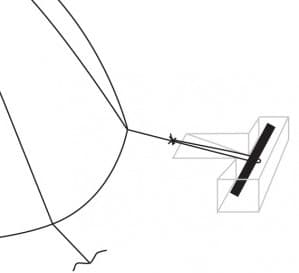
Deadman stake employed to stake out a tent.
An inexpensive, very packable and light weight deadman is a simple fabric parachute. These are rip stop squares (18″-24″) with line attached to each corner. Just pack them full of snow and then bury them in the snow and attach a guy line to them.

Fabric bags can be carried to fashion onsite deadman anchors.
If you have the wire stakes, a way to get more holding power is to take pairs of the stakes and bury them as an “X” rather than a single cross-bar “T”.
When it’s time to leave, untie the loop in the guy line and pull out the line. To get the deadman out of the ground the next morning, it is usually easiest to use an axe to chop away the snow.
8.5.3.3 Alternative Staking Options
Other staking options include using – skis, ski poles, ice ax, snow shovels, spare stuff sacks filled with snow. Or one can position your tent between several closely grouped saplings and use them as tether point.
8.6 Snow shelters
Snow is a very good insulator. Snow also is a very effective windbreak – if your shelter is constructed so that the snow you use doesn’t blow away in the wind. Snow shelters include quinzees, snow caves and igloos.
Quinzee: Quinzees are fairly quick to build but do require a fair amount of energy to construct. Build a big pile of snow, allow the snow to settle and compress and then hollow out the pile to create a cavity that is uniform and with walls at least 12 inches thick all around.
Snow cave: To build a snow cave find a suitable location, usually on the leeward side of a small hill or natural rise in the landscape where snow drifts tend to form. Dig into the drift creating a hollow and you have a snow cave. A snow cave can be an effective shelter option for a single person. Finding a suitable location however, is often a hit or miss proposition
Digging a quinzee or caves requires a lot of energy and usually results in a lot of sweating – not good in cold weather. Having several people on hand to take turns digging and wiping snow off of clothing is usually a good idea. Take your time and take lots of breaks to prevent overheating,.
Igloo: An igloo is by far the best option for all around protection from the elements. It is possible to build snow blocks from just about any type of snow that is available. Using a mould to pack the snow into the right size and shape makes building a top quality igloo easier. Using a snow mold allows even a novice winter architect to construct an adequate shelter in as little as 2-4 hours. An igloo is a very sturdy shelter that can last for months and gets better with every snowfall.. A uniform shape maximizes stability and insulation and wind stopping power. Temperatures inside an igloo often hover in the 37-41F degree range with the addition of body heat and a small candle/flame.
8.6.1 Quinzees
A quinzee (also quinhzee) is a combination of an igloo and a snow cave. Quinzees are suitable in marginal snow conditions, or when a crust is not available for igloos, or when there is not enough deep packed snow for a snow cave. On the flip side a quinzee won’t last an entire winter season as do some igloos. Usually quinzees are made for 2-3 sleepers.
Quinzees require a fair bit of work to complete and are usually used when spending more than one night in the same spot. If built properly a quinzee will be warmer to sleep in than a tent.
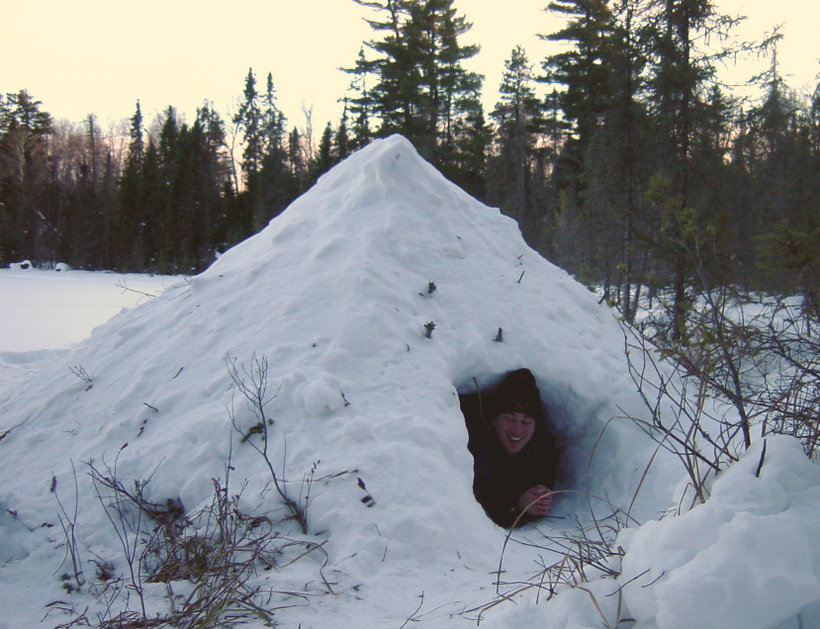
A quinzee is an easy to build snow shelter
8.6.1.1 How to Build A Quinzee
- To build a quinzee one shovels snow into a pile the shape and size of an igloo and then waits for the snow structure to sinter. Sintering is a process whereby snow crystals adhere to one another and form a bond making a harder structure. The sintering process may take a couple of hours to complete. If you are really organized you can bury your backpacks and then pull them out later in the tunneling process to reduce the amount of digging that has to be done. However, the items in the backpacks will be unavailable for a few hours, so make sure you have the items (e.g. stove, hot drinks, and extra clothes) that you might want during the interim.
- Gather sticks approximately 12″ in length and jab them all over your quinzee. These sticks will be the guides for the thickness of the cave walls.
- Dig an entrance at ground level and as you tunnel inside, slant upwards to create a raised sleeping platform. Warm air rises, so this will allow the cold air to flow down and out while you’re sleeping.
- As you uncover the ends of the sticks, you will have a 12″ wall at that location. This step will take the most time as only one person can excavate the inside while others outside move the snow away from the entrance (and stand around and get chilled). Expect the tunnel person to get snow-covered and/or wet when building the quinzee so make sure you have alternative clothing.
- Try to keep your structure rounded. If you have a flat roof the quinzee will sag and eventually collapse
- Pile up the excavated snow along the sides of your entrance to create a windbreak.
- Smooth the ceiling as much as possible then light a candle or other heat source to glaze the interior surfaces.
- Punch ventilation holes with a stick. Check the ventilation holes frequently and keep them clear.
- If you have a tarp lay it down on the floor. If the weather is really nasty you can use your backpack to partially block the entrance door from drafts. Temperatures inside a snow shelter can be 32 degrees or warmer even when the outside temperature dips into negative digits.
8.6.1.2 WinterCampers.com Experience with a Quinzee
On a dog-sledding winter camping trip in the Boundary Waters Canoe Area Wilderness we established a base camp on Eskwagame Lake. While our guides slept out in bivouac and 4 of us slept in the tipi, Jason and Paul decided to make and sleep in a quinzee.
They constructed a quinzee using the steps previously described– except they might have made it a little on the small side. At 2am those of us in the tipi heard “I’ve GOT to get out of here!” followed by an explosion of nylon and snow as Paul was overcome by claustrophobia and exited the quinzee in a rush. Jason reported sleeping comfortably, but admitted that space was tight. Paul slept the rest of the night under the stars and Jason benefitted from the extra space.
8.6.2 Snow caves[4]
During the winter, one can sometimes see a ptarmigan making its home for the night: In full flight, the plump white bird will suddenly dive into a soft drift, hunker down in the resulting depression, and let blowing flakes settle on its feathers to form a protective blanket.
Snow, you see, is one of nature’s most practical insulators. The falling flakes, each of which may contain more than a thousand loosely clustered ice crystals, can pile up into a fluffy mass (composed of as much as 90% air) that is virtually—in form and effect—the frozen equivalent of goose down.
Many of nature’s creatures, in fact, use the heat-retaining qualities of snow for protection from winter’s cold. But we humans, in all of our “wisdom”, generally cling to our dependence upon technology . . . even in situations such as winter mountaineering trips, where—for shelter—we most likely sit huddled within the frigid confines of thin rip stop nylon walls. Worse yet, some individuals have actually perished needlessly from “exposure” to snow and cold, when a little knowledge of the resources at hand—and an ability to use those materials—could have saved their lives.
8.6.2.1 Selecting a Site For your Snow Cave
An ideal spot for a snow cave would be a firm bank or drift that’s six feet or more deep. But not everyone who needs winter shelter, of course, will find a place where the precipitation is that substantial, and even those who do will sometimes discover—early in the season, especially—that the piled crystals are too loose and powdery to make good caving material.
Fortunately, one of the characteristics of snow is that it tends to compact itself (and harden) once it’s been disturbed. So when the cover is too shallow to accommodate a cave, you can build yourself an “artificial” drift in which to burrow: Find a hill that’s 10 to 20 feet high and covered with 24 inches or more of snow, and then—with a shovel, your feet, or whatever—push the snow down the incline to form a large pile at the bottom. With that done, wait 10 to 20 minutes to let the material “set”, and then proceed to dig your cave.
Likewise, if you find a site where a drift is sufficiently deep but not firm, you can tromp around the area and poke the powder repeatedly with a stick or your ski poles also mounding more snow on top and stirring that up a bit—to encourage the mass to harden.
In any case, it’s important to remember that if you’re in an avalanche-prone area, you need to be very careful about choosing a site. Always check with rangers for snow condition reports before venturing into the wilds . . . and be aware that the lee—windless—sides of mountains are particularly dangerous, and that new snow on the ground increases the danger of a slide.
8.6.2.2 Construction of a Snow Cave
Virtually every book I’ve read on the subject of snow caving recommends carving a narrow tunnel into a drift or bank, and then hollowing out a larger living area—at the interior end of the shaft—by scooping out the material and transporting it through the burrow to the outside. I’ve found, however, that the method is very time-consuming . . . and that a digger is likely to get a kink in the back—and snow down the neck—in the process.
Therefore, I’ve come up with what I believe is a much better technique: First, open a large vertical hole (about four feet on a side, working from “ground” level up) directly into a drift or pile of snow. You can use a lightweight folding shovel—a tool that I think all winter back-country enthusiasts should carry—or, in a pinch, some kind of make-do implement . . . such as a snowshoe, ski, or flat stick.
When the “doorway” is done, go on to excavate your living quarters by digging out a rounded, dome-shaped area (a flat roof will sag and collapse) that’s somewhat wider and higher than the entrance itself. The exact dimensions of your abode will, of course, be up to you . . . and will depend upon the number of people you intend to house. Given the right snow conditions, you can construct caves large enough for six or more individuals . . . but a smaller shelter—such as the two—person model shown in Figs. 1 and 2—takes less time to build, tends to be more stable, and is a more appropriate project for beginners.
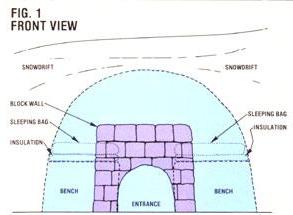
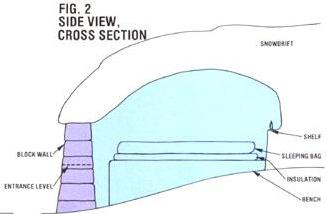
Views of a snow cave
Once you’ve hollowed out the cubicle, take some of the loosened snow and pack it up to form a sleeping bench (or two or three) that’s 20 inches or more high, a bit wider than a sleeping bag, and as long as its occupant-to-be is tall. If you’re building a one-person shelter, you can dig a fairly shallow chamber and position the single platform parallel to the opening. If you’re making a two-person grotto like the one in the accompanying illustrations, you’ll need to excavate a deeper cavity and place a bed on each side of the doorway.
After you’ve finished contouring each bench to your satisfaction, lay a backpacking pad on top, and cover that with your sleeping bag. Be careful not to put any substantial weight on the bench just yet, however you’ll need to give the snow a chance to settle before you take your first nap.
Since the next major step in the cave construction is to block up the original 4′ X 4′ entry hole, it’s a good idea to move the rest of your gear inside first. (This is another advantage of my snow-caving technique . . . you don’t have to push, pull, and squeeze your equipment through a tiny, confining burrow to get it under shelter.) You may also want to carve a shelf or two in the cavern’s interior surface, to hold a candle and other small items . . . and thrust a short stick partway into the wall to make a handy clothes hook.
Now—using your shovel, a snow saw, or just your hands—fashion “bricks” from the material that you scooped out of the cavity. For starters, try to make a number of cakes that are the approximate size (precision isn’t required here) of a standard 8″ X 8″ X 16″ cinder block, and then—as you build the wall—custom-tailor whatever others you need to fit specific spaces.
To fill the opening, lay the bricks in courses just as a mason might. Start with a horizontal foundation of end-to-end bricks across the entrance, and then position each block in the succeeding rows so that—whenever possible—it straddles the juncture of the two cakes below it. Remember, too, to spread a handful or so of snow “mortar” between the chunks as you work. The final product will be a sturdy wall that completely closes off the cavity, bottom to top.
At this point, take a break (gather firewood, get some camp chores done, go on a hike, whatever) and allow the wall a chance to firm up. After 20 minutes or so, you and your domicile will be ready for the last few construction steps.
Using a shovel or flat stick, cut a small entrance hole (this one should be just big enough to crawl through) in the bottom center of the snow-brick wall. Ideally, the highest part of the opening should be lower than the top surface of the sleeping benches (rising body heat will then be contained inside the cave), so dig down as close to “floor” level as you can when you cut this cavity.
8.6.2.3 A Few Final Pointers
Experience is the best teacher of all and that’s certainly the case when it comes to developing a proficiency at building (and camping in) snow shelters. After a few winter back-country outings, for example, you’ll acquire a sensitivity to the different kinds of snow—in terms of texture, moisture content, and “pack ability”—and to the degree to which varying conditions will affect the type of shelter you should (and/or can) build. New precipitation, for instance, is often too fluffy to make good material for a large cave but might be just fine for a one-person chamber.
You’ll also learn, rather quickly, that it’s important to pace yourself as you work making sure that you don’t perspire excessively and—as a result—become overly (and perhaps dangerously) chilled. Always dress in layers; too, so that you can adjust the amount of clothing you’re wearing to suit the weather and the activity at hand. And remember: To stay dry is to stay warm.
In addition, you may find that it takes some time to accustom yourself—both physically and psychologically—to life in a snow cave. You can’t expect such a shelter to be the Waldorf-Astoria, but the grotto’s temperature will hold at a range of 30° to 38°F (once you’ve been inside for a while), and neither you nor such items as jugs of water will freeze even if the mercury outdoors dips to 30 below. Should you be caught in an emergency situation without a sleeping bag, then, a snow cave will still keep you relatively warm. If necessary, you can use a few isometric exercises (tense the muscles in your legs, hands, and feet for several seconds, then let them relax, to stimulate blood flow) off and on through the night to avoid frostbite.
Some folks find that the darkness and silence inside a snow cave can be disturbing so be prepared, when you blow out your candle that first night in your shelter (and do be sure to extinguish the flame, so that it doesn’t consume oxygen while you’re sleeping), to cope with an instant attack of claustrophobia. Most people get used to the quiet and close quarters in a very short time, however.
During the day, if you leave the cave – to go for a hike or gather firewood or whatever – be sure to mark the entrance conspicuously so that you’ll be able to find your home when you return. Remember, too, that snow has a way of “swallowing” camp litter trash that, come spring, will show its ugly face all too plainly. Be sure to keep all refuse and waste in one place, and to pack it out with you when you leave.
And finally, practice building snow shelters before placing yourself in a situation where you might need such a structure. A wilderness emergency—such as getting caught in a sudden blizzard—is not the ideal time to try to construct your first snow cave. And reading the information in this article and in other books is not, by itself, sufficient preparation for going on an overnight cross-country tour without a tent.
With experience, you should be able to carve out a shelter in an hour or less so take some time this winter to teach yourself the art of snow caving. Find an appropriate site close to home, and spend an enjoyable afternoon or two practicing construction techniques. Once you’ve polished your skills, you’ll be able to explore the wonders of winter’s wilderness with confidence knowing full well that a warm, comfortable home is never more than a few feet of snow away.
8.6.3 Igloos[5]
Provided temperatures remain below 32 degrees F, constructing snow shelters is relatively easy. Sheltering from the wind is the first priority, since the wind can drastically decrease the air temperature. Temperatures below 14 degrees F become increasingly unpleasant, so that it becomes necessary to construct shelters in which heat can be retained extremely well. These can range from a simple, hollowed-out heap of snow to an igloo, which can take a few hours to construct. In a long-term shelter, such as an igloo, heavy, cold air can be diverted away from the occupants by digging a cold sink to channel the air down and away from the shelter. It is important to allow for adequate ventilation in all snow shelters in order to prevent suffocation.
1. Cut blocks from dry, hard, hard snow, using a snow saw or large knife. Each block should be about 3 ft. (1m) long, 15 in. (40cm) high, and 8 in. (20cm) deep.
2. Form a circle with blocks around the hole created where you cut the blocks. Cut the circle in a spiral from the top of the last block to the ground ahead of the first block. This will make it easy to construct a dome.
3. Build up walls, overlapping the blocks and shaping them so that they lean inward. Cut a hole under the wall for the cold sink and entrance. Put several blocks along one wall as a sleeping platform
4. The last block must initially be larger than the hole. Place the block on top of the igloo, then, from inside, shape and wiggle it to slot exactly into the hole.

Completing an igloo
5. Hot air from your body and stove rises and is trapped inside the dome. Cold air falls into the sink and flows away to the outside. It is essential to cut ventilation holes in the walls with an ice ax.
Finished Igloo. With warmth inside the igloo, the surface of the walls will melt and freeze over, to form a smooth, airtight ice surface. The roof over entrance tunnel prevents snow from blowing into igloo.
It is vital to make at least one air hole in the roof to avoid suffocation. The igloo will get very warm inside with heat from your body, even if it is cold and windy outside. Without ventilation, lethal carbon dioxide will build up. Also, the use of stoves in an enclosed shelter is not recommended due to dangerous build-up of carbon monoxide.
[1] http://www.whiteblaze.net/forum/forumdisplay.php?34-AT-Shelters-amp-Lean-tos
[2] http://www.adkforum.com/index.php
[3] http://www.easternslopes.com/2010/01/28/warmcold-winter-backpacking/
[4] Ernest Wilkinson, Mother Earth News Issue # 078 – November/December 1982. “Learn how to build safe, snug snow caves and other havens in winter wilderness, plus helpful information on winter camping. “ From http://www.motherearthnews.com/Do-It-Yourself/1982-11-01/Snow-Caves-and-Other-Shelters.aspx
[5] “The Complete Wilderness Training Guide” written by Hugh McManners and published by Dorling Kindersley. From Chapter Three, “Living In The Wild”
